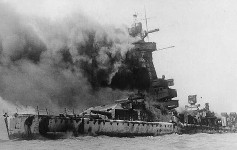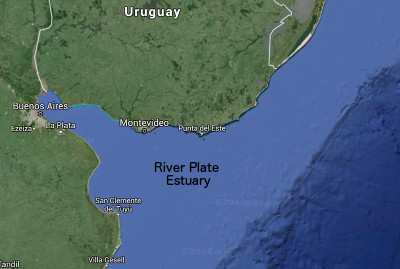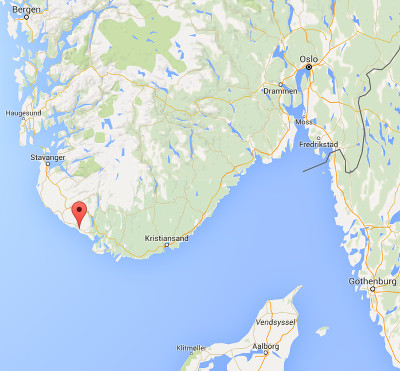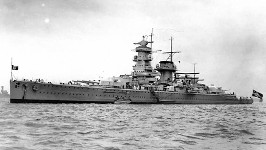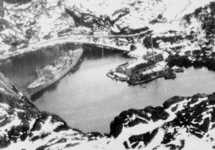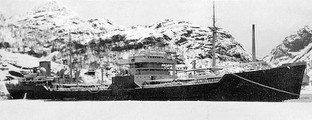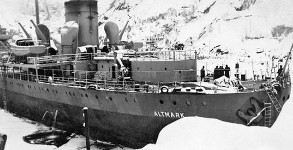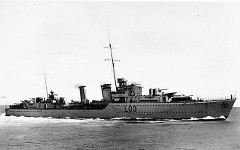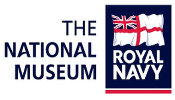|
| Admiral Graf Spee scuttled and on fire 17 December 1939 (click to enlarge) | return to World War 2 |
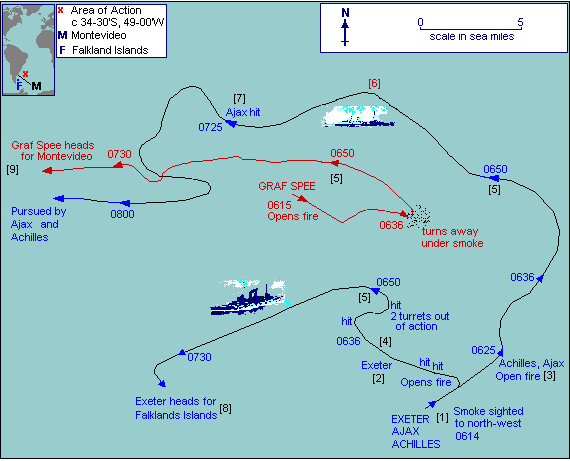
Battle of the River Plate, details from "The War at Sea" by Roskill
|
Introduction
This is an introduction to the first major sea battle of World War 2 using the highly readable and frankly thrilling London Gazette despatch, penned by Rear Admiral Harwood who was on the bridge of HMS Ajax throughout the action. Honours have also been added from the London Gazette, together with the casualty lists compiled by Don Kindell. Also included are the honours awarded to crew members of some of the merchant ships captured by the Admiral Graf Spee. As these were also involved in the action to free Allied merchant seamen from the German tanker Altmark in southern Norway, Royal Navy honours for this action are also listed. Thanks as always to Photo Ships for most of the images. Gordon Smith
Naval-History.Net Contents
London Gazette Despatch (right)
Events in Outline Background Maps Ships Taking Part British Casualties - Battle of the River Plate British Honours and Awards - Battle of the River Plate EVENTS
IN OUTLINE
Atlantic - September 1939 Pocket battleship "Admiral
Graf Spee" sank her first ship in the Atlantic off Brazil
on the 30th September.
Atlantic - October 1939
"Graf Spee" claimed four more
merchant ships (including Huntsman on the 10th and
Trevanion on the 22nd) in the South Atlantic before
heading into the southern Indian Ocean. Seven Allied
hunting groups were formed in the Atlantic and one in the
Indian Ocean to search for her. In total the Royal and
French Navies deployed three capital ships, four aircraft
carriers and 16 cruisers.
Atlantic - November 1939
"Graf Spee" sank a small
tanker southwest of Madagascar and headed back for the
South Atlantic. More Allied hunting groups were formed.
Atlantic - December 1939
13th, Battle of River Plate
(see map above) - Now back in the South Atlantic, “Graf
Spee” claimed three more victims (including Doric Star on
the 2nd and Tairoa on the 3rd; by this stage, may of
the prisoners were on board the German tanker "Altmark")
to bring the total to nine ships of 50,000 tons, before
heading for the South American shipping lanes off the
River Plate. Cdre Harwood with Hunting Group G -
8in-gunned cruisers Exeter and Cumberland and 6in light
cruisers Ajax and New Zealand Achilles - correctly
anticipated her destination. Unfortunately “Cumberland”
was by now in the Falklands. At 06.14 on the 13th, 150
miles east of the Plate Estuary, “Graf Spee” (Capt
Langsdorff) was reported to the northwest of the three
cruisers [1 - see map]. Faced with “Graf Spee's" heavier
armament, Cdre Harwood decided to split his force in two
and try to divide her main guns. “Exeter” closed to the
south [2] while the two light cruisers worked around to
the north [3], all firing as they manoeuvred.
“Graf Spee” concentrated her
two 11in turrets on “Exeter” which was badly hit [4]. By
06.50 all ships were heading west [5], "Exeter” with only
one turret in action and on fire. “Ajax” and “Achilles”
continued to harry the pocket battleship from the north
[6], but at 07.25 "Ajax" lost her two after turrets to an
11in hit [7] and “Achilles” already had splinter damage.
HMS Exeter was forced to break off and head south for the
Falklands [8], but "Graf Spee" failed to press home her
advantage. By 08.00, still with only superficial damage,
she headed for the neutral Uruguayan port of Montevideo,
the cruisers shadowing [9]. “GRAF SPEE” entered port at
midnight. As other Allied hunting groups headed for the
area, much diplomatic manoeuvring took place to hold her
there. Finally, on the 17th, Capt Langsdorff edged his
ship out into the estuary where she was scuttled and blown
up. Only “Cumberland” had arrived by this time. Langsdorff
then committed suicide.
Europe - February 1940
16th, The “Altmark” Incident
- "Altmark" was “Graf Spee's” supply ship with Merchant
Navy prisoners onboard. She was located off Norway and
took refuge in Jossingfiord, within territorial waters.
That evening destroyer “Cossack” (Capt Vian) went
alongside with a boarding party and after a short struggle
released the prisoners with the cry 'The Navy's here!'
Location of Jossingfiord,
southern Norway (Google)
SHIPS TAKING PART (with links to British ship histories) German
armoured ship/"pocket
battleship" Admiral Graf Spee (6-11in, 8-5.9in, 8-21in
tt)
oiler Altmark, Jossingfiord action British heavy cruiser Exeter,
1st Division - light cruiser Achilles,
Ajax (total
armament - 6-8in, 12-6in, 12-4in, 22-21in tt)
oiler Olynthus heavy cruiser Cumberland, after the action destroyer Cossack, Altmark Incident, Jossingfiord BATTLE OF THE RIVER PLATE KMS Admiral Graf Spee
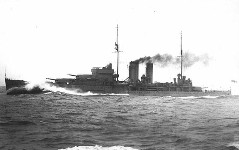 HMS Exeter 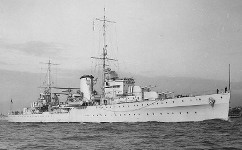 HMS Ajax 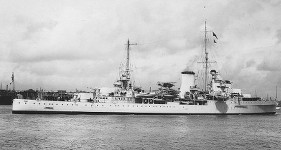 HMS Achilles 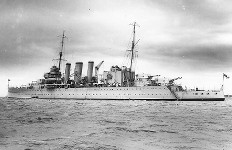 HMS Cumberland 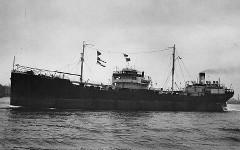 RFA Olynthus AFTERMATH 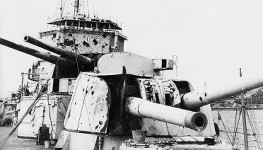 A and B turrets, HMS Exeter (Maritime Quest) 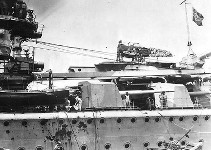 damage to Admiral Graf Spee - burnt out aircraft 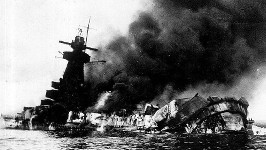 scuttled and ablaze off Montevideo 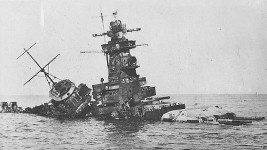 wrecked CASUALTIES ROYAL NAVY (with thanks to Don Kindell) Wednesday,
13 December 1939
BATTLE OF THE RIVER PLATE Achilles, light cruiser (RNZN) GRANT, Ian,
Ordinary Seaman, 1734 (NZD), killed
MILBURN, Neville, Ordinary Telegraphist, D/SSX 23288, killed SHAW, Archibald, Able Seaman, 1030 (NZD), killed STENNETT, Frank, Telegraphist, D/JX 148899, killed Ajax, light cruiser BASHFORD, Cyril,
Corporal, CH/X 959, killed
BURRELLS, Albert, Marine, CH/X 1688, killed CLEMENTS, James, Marine, CH/X 654, killed FARLEY, William, Ordinary Seaman, C/JX 151605, killed FOLLETT, Harry, Sergeant, CH/X 688, killed FRANCOM, Ernest, Steward, C/LX 21835, killed LAMBARD, William, Marine, CH/X 1663, killed Exeter, heavy cruiser AINGE, Walter,
Chief Petty Officer, D/J 52100, DOW
BACK, Frederick,
Engine Room Artificer 4c, D/MX 54489, killed
BETHELL, Frank, Able Seaman, D/JX 151055, killed BETHELL, Joseph, Able Seaman, D/SSX 22452, killed BLANDFORD, Bert, Marine, PLY/X 711, killed BOWES, Raymond, Ordinary Seaman, D/JX 150342, killed BOWMAN-MANIFOLD, John, Lieutenant Commander, killed BRIGHT, Daniel, Stoker Petty Officer, D/KX 78984, killed BURRAS, Stanley, Stoker 1c, D/KX 92228, killed CAMPBELL, Frederick, Stoker 1c, D/KX 88775, killed CLARKSON, Richard, Able Seaman, D/JX 151372, killed CROKER, Alfred, Marine, PLY/X 835, killed DAVIES, Gilbert, Able Seaman, D/SSX 22679, killed DOVE, Gilbert, Act/Petty Officer, D/JX 134624, killed DYER, Frederick, Shipwright 3c, D/MX 47145, killed FRENCH, Frederick, Able Seaman, D/SSX 20765, killed GIBSON, Stanley, Able Seaman, D/JX 139907, killed HARRINGTON, Stanley, Marine, PLY/ 22286, killed HARRIS, Hugh, Petty Officer Telegraphist, D/J 51924, killed HIGGINBOTTOM, Alan, Chief Yeoman of Signals, D/J 100565, killed HILL, Ronald, Boy Bugler, PLY/X 2238, killed HONEY, Leslie, Leading Signalman, D/JX 138212, killed JONES, Albert, Stoker Petty Officer, D/K 65933, killed KAVANAGH, Michael, Telegraphist, D/SSX 16949, killed KELLY, Albert, Stoker 1c, D/KX 82448, killed LUMSDEN, Arthur, Telegraphist, D/JX 142445, killed MACLEOD, William, Stoker 1c, D/KX 81482, killed MANNING, George, Stoker 1c, D/K 59242, killed MARSH, William, Corporal, PLY/X 1361, killed MCDONNELL, Francis, Able Seaman, D/SSX 15579, killed MCEVOY, James, Marine, PO/X 2091, killed MILLS, Edward, Marine, PLY/X 1914, killed MONKS, Christoper, Stoker 2c, D/KX 96243, killed MORSE, Clyde, Act/Sub Lieutenant, MPK NAYLOR, Thomas, Able Seaman, D/JX 138243, killed O'LEARY, Patrick, Stoker 1c, D/KX 92212, killed PARRY, David, Telegraphist, D/JX 141568, killed PETT, Bryan, Stoker 1c, D/KX 92198, killed PULLYBLANK, Leslie, Leading Supply Assistant, D/MX 50647, killed RANDLE, Frank, Stoker Petty Officer, D/K 37155, killed REMICK, Tom, Chief Yeoman of Signals, D/J 45240, killed RICHARDS, Brynmor, Able Seaman, D/JX 141181, killed RICHARDS, Glyndwr, Leading Seaman, D/JX 127862, killed RICKCORD, John, Midshipman, killed RIGLAR, Arthur, Telegraphist, D/JX 144826, killed SMALL, Richard, Blacksmith 3c, D/MX 51352, killed SPENCER, Harry, Able Seaman, D/SSX 16592, DOW SQUIRE, Ernest, Boy 1c, D/JX 158659, killed STEELE, Robert, Stoker Petty Officer, D/K 60833, killed STUBBS, Agean, Marine, PLY/X 1370, killed TAYLOR, Robert, Telegraphist, D/JX 146419, killed TEAGUE, Samuel, Chief Petty Officer Stoker Petty Officer, D/K 57454, killed THOMPSON, James, Stoker 1c, D/KX 81575, killed TOVEY, George, Stoker Petty Officer, D/KX 80186, killed TREGIDGO, Albert, Chief Petty Officer, D/J 89888, killed TYLER, Donald, Paymaster Sub Lieutenant, killed WILSON, Patrick, Stoker 1c, D/KX 86441, killed WOODS, Humphrey, Captain, RM, killed Thursday,
14 December 1939
Exeter, heavy cruiser HILL, Leonard,
Able Seaman, D/J 44825, DOW
PHILLIPS, Alfred, Act/Leading Seaman, D/JX 142946, DOW Friday,
15 December 1939
Exeter, heavy cruiser GEORGE, Evan,
Leading Stoker, D/K 65213, DOW
Saturday,
16 December 1939
Exeter, heavy cruiser LEGG, Frank, Petty
Officer Cook, D/MX 52427, DOW
Sunday,
17 December 1939
Exeter, heavy cruiser POWTON, Richard,
Chief Petty Officer Cook, D/M 27983, DOW
Saturday,
23 December 1939
Exeter, heavy cruiser COLLINGS, Anthony,
Chief Shipwright 2c, D/M 143336, DOW
Saturday,
20 January 1940
Exeter, heavy cruiser RUSSELL, Wilfred
A, Marine, PLY/X 214, DOW
ALTMARK INCIDENT, JOSSINGFIORD, 16 February 1940 There
were no Royal Navy deaths, injuries not known
BRITISH
HONOURS AND AWARDS
BATTLE OF THE RIVER PLATE Recorded in The London Gazette, issue 34759, 22 December 1939 SECOND SUPPLEMENT
TO
The London Gazette Of FRIDAY, the 22nd of DECEMBER, 1939 SATURDAY, 23 DECEMBER, 1939 CENTRAL CHANCERY OF THE ORDERS OF KNIGHTHOOD. St.
James's Palace, S.W.1,
23 December, 1939. The KING has been graciously pleased to give orders for the following appointments to the Most Honourable Order of the Bath, in recognition of the gallant and successful action with the "Admiral Graf Spee" (to be dated the 13th December, 1939). To be an Additional Member of the Military Division of the Second Class, or Knights Commanders, of the said Most Honourable Order: Rear-Admiral Henry Harwood Harwood, O.B.E., Commanding South American Division of the America and West Indies Station. To be Additional Members of the Military Division of the Third Class, or Companions of the said Most Honourable Order: Captain William Edward Parry, R.N., H.M.S. Achilles. Captain Charles Henry Lawrence Woodhouse, R.N. H.M.S. Ajax. Captain Frederick Secker Bell, R.N., H.M.S. Exeter. Recorded
in The London Gazette, issue 34796,
20 February 1940
SECOND
SUPPLEMENT TO
The London Gazette Of TUESDAY, the 20th of FEBRUARY, 1940 FRIDAY, 23 FEBRUARY, 1940 Admiralty,
Whitehall.
23 February, 1940. The KING having already been graciously pleased, after the first phase of the Battle, to give orders for the following appointments to the Most Honourable Order of the Bath, in recognition of the gallant and successful action with the "Admiral Graf Spee" (to be dated the 13th of December, 1939): To be an Additional Member of the Military Division of the Second Class, or Knights Commanders, of the said Most Honourable Order: Rear-Admiral Henry Harwood Harwood, O.B.E., Commanding South American Division of the America and West Indies Station: To be Additional Members of the Military Division of the Third Class, or Companions, of the said Most Honourable Order: Captain William Edward Parry, R.N., H.M.S. Achilles, Captain Charles Henry Lawrence Woodhouse, R.N., H.M.S. Ajax, Captain Frederick Seeker Bell, R.N., H.M.S. Exeter; An announcement to this effect was published on the 23rd of December in the Second Supplement to the London Gazette of Friday the 22nd of December, 1939. (above) His Majesty has now been further graciously pleased to give orders for the following appointments to the Distinguished Service Order for services in the same action: To be Companions of the Distinguished Service Order: Captain Douglas H. Everett, M.B.E., Royal Navy, H.M.S. Ajax, Commander Douglas M. L. Neame, Royal Navy, H.M.S. Achilles, Commander Robert R. Graham, Royal Navy, H.M.S. Exeter; who, as Commanders of their Ships, having done all they could during the long months of waiting to perfect their Ships and Ships' companies, so that they stood the test of battle, when the day for action came, heartened all by their readiness, example and encouragement. Lieutenant Ian Dudley De'Ath, Royal Marines, H.M.S. Ajax; who, in charge of a Turret when an 11-inch shell passed through the working chamber below, went at once to the hatch, which had been blown open and was giving out sparks and smoke, to find out the damage. He gave the orders needed to ensure the safety of ammunition and at once did what he could to bring the Turret into action again. He set a fine example of courage and presence of mind. Lieutenant Richard E. Washbourn, Royal Navy, H.M.S. Achilles; who, when early in the action several splinters struck the Gun Director Tower, at once killing three men and wounding two others inside the tower, though wounded on the head by a splinter which half stunned him and killed the man behind him, continued to control the main armament with the utmost coolness. He set a magnificent example to the rest of the Director Tower crew, who all stood to their posts and made light of the incident. Thus the Primary Control kept working and secured throughout the action a high rate of hits on the enemy. Commander (E) Charles E. Simms, Royal Navy, H.M.S. Exeter; who, by his zeal and energy, brought his engines to full power in record time, and by his thorough knowledge of the ship and perfect organisation, checked the damage. His calm and cheerful manner set a fine example to his fellows. Distinguished
Service Cross.
Midshipman Archibald Cameron, Royal Navy, H.M.S. Exeter; who, when an 11-inch shell burst above an ammunition locker and set it alight, with great calmness and foresight ordered two guns' crews to take shelter. The locker exploded, wounding some of the second crew and setting alight another locker. As soon as the main fire abated, with the help of an Able Seaman, he smothered the flames of the burning woodwork. The two of them then threw the unexploded shells over the side. These were still hot and the brass cartridge cases were either missing or split open. The bottom row of ammunition had not burned, and this also was thrown over the side. Throughout the action he showed the utmost coolness and resource. He never failed to make the best use of his guns' crews. Conspicuous
Gallantry Medal.
William G. Gwilliam, Able Seaman, H.M.S. Exeter; who helped Midshipman Cameron to smother the flames of a burning ammunition locker, and to throw hot shells, with their brass cases either missing or split open, over the side. He showed no regard for his own safety in putting out fires on the Upper Deck near the aircraft from which petrol was leaking. Samuel John Trimble, Sergeant, Royal Marines, H.M.S. Achilles; who, early in the action, when several splinters struck the Gun Director, at once killing three men and wounding two others inside the tower, was severely wounded; but stood fast without flinching or complaint throughout the hour of action that followed, bearing his wounds with great fortitude. When the medical party came he helped them to move the wounded and then made his own way to the Sick Bay with little aid. Wilfred A. Russell, Royal Marines, H.M.S. Exeter; who, having his left forearm blown away and his right arm shattered when a Turret was put out of action by a direct hit from an 11-inch shell, refused all but first aid, remained on deck and went about cheering on his shipmates and putting courage into them by his great fortitude; and did not give in until the heat of the battle was over. He has since died of wounds. Stoker (First Class) Patrick O'Brien, H.M.S. Exeter; who, when ordered from the Damage Control Headquarters to make contact with the Main Switchboard, found his way through the Chief Petty Officers' Flat where an 11-inch shell had just burst. Through the dense and deadly smoke, escaping steam and high explosive fumes, he made contact with the Main Switchboard and so with the Engine Room Artificer in the Forward Dynamo Room. From there he returned by way of the Upper Deck and led his party into the reeking Flat. H.M.S.
Ajax.
Distinguished Service Cross. Lieutenant-Commander Desmond P. Dreyer, Royal Navy; who, as Gunnery Officer of the ship, controlled the fire with great skill and ensured the high efficiency of his department. Lieutenant Norman Kelsoe Todd, Royal Navy; who carried out navigating duties with the utmost coolness and accuracy throughout the action. Lieutenant Edgar D. G. Lewin, Royal Navy; who was catapulted after the action had started when the air-worthiness of his aircraft was in doubt, and made a landing and recovery under difficult conditions after the battle. Warrant Shipwright Frank Henry Thomas Panter, Royal Navy; who, when knocked down and wounded by the explosion of an 11-inch shell which started fires, filled the compartment with smoke and put out all lights, went at once to the centre of the damage, where he encouraged and directed the repair parties and did all he could to limit and control the ill-effects. Warrant Engineer Arthur P. Monk, Royal Navy; who made all preparations for catapulting the aircraft. He later went to the scene of the most serious damage and by hard and skilful work, devotion to duty and cheerful example, did much to keep heart in the repair parties. Gunner Reginald C. Biggs, Royal Navy; who, in charge of a Turret, dealt very well with the failure of one ammunition hoist, and by his zeal and energy saw to it that his guns fired all they could in the time, H.M.S.
Achilles.
Distinguished Service Cross. Lieutenant George G. Cowburn, Royal Navy; who handled the ship with the utmost skill and coolness and was undismayed when the Commanding Officer and the Chief Yeoman of Signals were wounded alongside him. The Ship's immunity from being hit was mainly due to him. The running commentary on the progress of the action which he passed to the Lower Conning Tower was of the greatest value, as it was broadcast to all positions between decks, including the Engine Room. Surgeon-Lieutenant Colin G. Hunter, Royal Navy; who was very junior for the responsible duty of Principal Medical Officer. He is a New Zealander. He had gained the confidence of the ship's company and won their esteem and affection, and so contributed much to the contentment of the Lower Deck. During the action his First Aid organisation worked very well, and he showed good judgment in dealing with the seriously wounded. Gunner Eric J. Watts, Royal Navy; who, though early in the action the Director Control Tower was hit by six splinters of a shell which killed or wounded half the personnel, carried out his duties as Rate Officer most ably throughout. When his rate keeping was no longer required, he left his position and calmly tended the wounded. Gunner Harry T. Burchell, Royal Navy; who, throughout the first action and the sixteen-hour chase which followed, carried out his duties with the greatest zeal and efficiency and relieved the Principal Control Officer of much trouble and responsibility, so that he could concentrate on observing and identifying the fall of shot. His conduct was exemplary. H.M.S.
Exeter.
Distinguished Service Cross, Commander Charles J. Smith, Royal Navy; who showed great calm and resource when communications had failed, in passing an order for port helm and in firing the starboard tubes at the correct moment. When required he conned the ship from aft, and after the action worked tirelessly to repair electrical damage, although wounded in the leg. Commander Richard B. Jennings, Royal Navy; who throughout the action controlled the?main armament with great calmness and?skill. When only one Turret was left in?action he tried to spot from the after?control position though standing over the?muzzles of the guns. Throughout and after?the battle he was untiring in his work of?keeping the turret in action and in directing?the ship's company to clear away the debris,?the Commander being wounded Lieutenant Aidan E. Toase, Royal Marines; who was very active and resourceful in assisting to render the turret safe after it had been hit by an 11-inch shell. Surgeon-Lieutenant Roger W. G. Lancashire, Royal Navy; who, during the action and throughout the passage to the Falklands, with no sleep, worked cheerfully and unceasingly in tending the wounded. Midshipman Robert W. D. Don, Royal Navy; who, throughout the action showed great calm, resource and initiative, especially in running hoses into the burning Marines' barracks, in fighting a fire over the lower steering position, and in rescuing the wounded. Warrant Shipwright Charles E. Rendle, Royal Navy; who controlled the shoring up and general repairs to the after section of the ship during the action. His untiring energy and great skill in effecting repairs, and so making the ship watertight after action, were beyond praise. H.M.S.
Ajax.
Distinguished Service Medal. Albert E. Fuller, Petty Officer; who was in charge of an electrical repair party near a compartment in which an 11-inch shell burst putting out all lights and causing much damage to electrical gear. He at once took efficient action to provide lighting and control the damage, and showed great courage, presence of mind and good leadership. William G. Dorling, Chief Mechanician (Second Class); who was in charge of the Stokers' Fire and Repair party near a compartment in which an 11-inch shell burst cutting pipes and starting fires. He at once took efficient action to control the damage and showed great courage, presence of mind and good leadership. Bertram Wood, Stoker (First Class); who showed special bravery, presence of mind and forwardness in controlling damage when an 11-inch shell burst near him. He entered "X" lobby when a number of casualties had occurred, and, single handed, put out a fire. Frank E. Monk, Stoker (First Class); who showed special presence of mind and forwardness in controlling damage when an 11-inch shell burst near him. Duncan Graham, Shipwright (Third Class); who set a magnificent example by his courage and forwardness near severe damage. James W. Jenkins. Electrical Artificer (Third Class); who showed special presence of mind and?forwardness in controlling damage when an?11-inch shell burst near him. Raymond G. Cook, Sergeant, Royal Marines; who showed great presence of mind and initiative in carrying out orders when a Turret was severely hit and fires and casualties occurred. Thomas S. Reginald Norman Buckley, Marine; who when a Turret was hit showed great presence of mind and efficiency in ensuring the safety of the ammunition. Clarence H. Charles Gorton, Petty Officer; who, being in charge of a Turret, worked hard and well, showed great devotion to duty, and ensured the maximum output from his turret throughout the action. John W. Hill, Petty Officer; who as Director Layer, carried out his most important duties with great skill thereby contributing much to the fighting efficiency of the ship throughout the action. Leonard C. Curd, Leading Seaman; who carried out most important Fire Control duties, usually performed by an Officer, with marked success throughout the action, and set a fine example of cheerful efficiency. Robert D. Macey, Able Seaman; who, being in charge of a Shell Room, set a fine example of cheerful and good hard work and ensured that there was no delay in ammunition supply in the Turret which was able to fire the greatest number of rounds. Robert McClarnan, Able Seaman; who, being in charge of a Magazine, set a fine example of cheerful, hard and skilful work. Richard C. Perry, Stoker (First Class); who worked with energy, skill and initiative in making repairs to the catapult motor during action. H.M.S.
Achilles.
Distinguished Service Medal. Edgar V. Sherley, Able Seaman; who was severely wounded when the Director Control Tower was hit by splinters. He behaved with great courage during his long wait until proper medical attention came. The nearest door of the D.C.T. through which he would normally have been evacuated was jammed by splinter damage, and it was necessary to remove him by a devious and difficult route in the heat of the engagement. He gave all the help he could to the Medical Party during this painful operation. He bore the pain of his wounds with great patience and fortitude. Ian Thomas L. Rodgers, Ordinary Seaman; who, when early in the action several splinters struck the Gun Director Tower at once, killing three men and wounding two others inside the tower, was immediately ordered across, and proceeded to carry out essential duty coolly and skilfully for the rest of the engagement. Allan M. Dorset, Boy (First Class); who, though early in the action several splinters struck the Gun Director Tower at once, killing three men and wounding two others inside the tower, behaved with exemplary coolness, despite the carnage around him. He passed such information as was available to him to the guns, and repeated their reports clearly for the information of the Gunnery Officer. William G. Boniface, Chief Petty Officer; who, though early in the action several splinters struck the Gun Director Tower at once, killing three men and wounding two others inside the tower, maintained a good range plot throughout the engagement. William R. Headon, Petty Officer; who, though early in the action several splinters struck the Gun Director Tower at once, killing three men and wounding two others inside the tower, kept up an accurate output for a prolonged action of over two hundred broadsides. He was faced with an especially difficult task in hand training; with large alterations of course at full speed and with wide angles of rudder. During the lull he helped to remove dead and wounded. Alfred Maycock, Petty Officer; who, though early in the action several splinters struck the Gun Director Tower at once, killing three men and wounding two others inside the tower, kept an accurate output for a prolonged action of over two hundred broadsides. During the lull he helped to remove the wounded and dead. Harry H. Gould, Able Seaman; who, though early in the action several splinters struck the Gun Director Tower at once, killing three men and wounding two others inside the tower, maintained throughout the engagement a good range plot, even when the body of a shipmate fell on him through the D.C.T. floor. Leslie Hood, Acting Chief Mechanician (Second Class); who was most helpful in the Engine Room, and showed zeal and energy throughout the action. William Job Wain, Chief Stoker; who was, in the words of one of the staff of "A" Boiler Room, an "inspiration and help to them all." He steamed this boiler room with the highest efficiency, using great initiative in setting and adjusting the sprayers to obtain the best flame and a minimum of smoke. Lincoln C. Martinson, Chief Yeoman of Signals; who showed great zeal and untiring energy in training and organising the V/S Department. The smartness of Achilles' flag-hoisting had been commented on both by the Commodore Commanding, New Zealand Squadron, and the Rear Admiral Commanding, South America Division, and did not fail in battle. When seriously wounded and in great pain, he continued to inquire after the welfare of the V/S department and wanted to know how his men were doing. William L. Brewer, Chief Petty Officer Telegraphist; whose training and organisation of the W/T department successfully withstood the supreme test of battle. His coolness and ability, when under fire, in repairing damage to W/T equipment, on the upper deck and below decks, resulted in Achilles' W/T being in full working order again in a very short time, and in getting the first Enemy Report through. George H. Sampson, Chief Ordnance Artificer (First Class); whose skilful maintenance of the gun armament material secured that at the end of the action all guns were fully in action and all hoists working. At no time was the rate of fire of any turret slowed up by any failure in the ammunition supply or by any defect. Albert G. Young, Cook; whose energetic example and most cheerful demeanour were an inspiration to the rest of his quarters during the whole of this action and the sixteen hour chase that followed. Frank T. Saunders, Sergeant, R.M.; who acted with courage and initiative throughout the engagement, overcoming each difficulty and breakdown as it occurred, and by his fine example and leadership urged his quarters to still further efforts. H.M.S.
Exeter.
Distinguished Service Medal. James McGarry, Engine Room Artificer, Second Class; who on his own initiative at the beginning of the action flooded the petrol compartment. After the two shell bursts near him and in dense fumes, with dead and dying around him, himself blown against a bulkhead and temporarily stunned, he maintained complete charge. He got Shipwrights to investigate damage and organised stretcher parties and the work in his area. On the arrival of the Engineer Officer he made a complete report while a messenger supported him. Frank L. Bond, Engine Room Artificer, Fourth Class; who, on a shell entering the Flat in which he was, stood fast in the dense fumes, and, waiting until the last man was reported clear of a Magazine, then flooded it. He then went to the main centre of the fire to ascertain damage. He found the flooding valve spindles shot away, the fire main shattered but enough flow of water into-the magazine from the damaged fire main. So he carried on fighting the fire in the Chief Petty Officers' flat. After the action he performed his duties with marked zeal and cheerfulness. Arthur B. Wilde, Sergeant, Plymouth; who, ordering the evacuation of a Turret after the Gun House had been hit by an eleven-inch shell, calmly put a tourniquet of rope round the stump of a Marine's arm. He then returned to the Gun House where he found a fire over the rammer of the left gun. This rammer contained a charge of cordite. He organised a chain system of buckets to the turret, put out the fire, removed the cordite, and threw the charge over the side. Herbert V. Chalkley, Acting Petty Officer; who, shortly after an eleven-inch shell burst in the Chief Petty Officers' Flat above the dynamo room in which he was, managed to open the door in the escape truck and crawl over the wreckage to the switchboard hatch. He could not clear the wreckage away, and realising that his services could be dispensed with in the dynamo room, he scrambled up the dynamo escape trunk to the upper deck, returned to the flat and helped the fire parties in getting the fire under control and isolated circuits there. The conditions in these two flats were very bad at the time that he was trying to escape from the dynamo room. His work with the fire parties was outstanding. Charles D. Pope, Sick Berth Chief Petty Officer; who, when returning from the fore part of the Sick Bay with bottles of Morphine Sulphate Solution, was knocked flat and temporarily unconscious by a shell bursting and badly perforating that end of the Sick Bay. The bottles were broken, but when he recovered he went back through the smoke and fumes and not finding more solution brought back with him Morphia Ampoules. Throughout the action he displayed great coolness, initiative and cheerful optimism despite the floods in the Sick Bay. After the action his nursing and devotion to the wounded was exemplary. Charles F. Hallas, Petty Officer; who was the Torpedo Gunner's Mate in charge of the torpedo tubes. Although wounded at the start of the action he remained at his station until all torpedoes were fired. He then formed parties to deal with fires on deck and help the wounded. After the action he worked unceasingly in repairing damaged circuits. His cheerfulness throughout was a great encouragement to all who were working with him. John L. Minhinett, Stoker, First Class; who, when taken wounded to the After Medical Station, refused all attention until he was certain that the message he had been carrying had been delivered. This message stated that the steering had been changed over to Number 3 position. Eric A. Shoesmith, Acting Leading Airman, F.A.A.; who on his own initiative, despite his clothing being soaked in petrol, climbed on to the top of the centre section of the aircraft and cleared the triatic stay which had fallen across it, thus freeing: the aircraft for jettisoning. While he did this the ship was under heavy fire, the petrol leaking from the aircraft was a great danger, and a Turret was firing on a forward bearing. George E. Smith, Plumber, Third Class; who, shortly after the explosion in the Chief Petty Officers' Flat, took a party of Stokers there to free the Main Switchboard Room's hatch. At the time the flat was in darkness, reeking with fumes and smoke, full of debris and with the possibility of little deck supporting. Frederick Knight, Joiner (Third Class); who, while bleeding in the face and badly shaken by the 11-inch shells exploding on the forecastle Messdeck, used great initiative in improvising stretchers for the wounded, in examining compartments underneath the damage and in plugging holes in the upper deck. William E. Green, Petty Officer; who, as Chief Quartermaster, when the upper steering position was put out of action by an 11-inch shell exploding on a Turret ensured that the secondary steering position was correct and fully manned. Finding it to be so he started aft to see that the after steering position also was correct; on his way he was seriously wounded. Joseph A. Rooskey, Chief Mechanician (Second Class); whose work was outstanding among all those on the catapult platforms jettisoning the aircraft. His calmness, skill and initiative were most valuable and set a splendid example to all those around him. Alfred J. Ball, Able Seaman; who when taken wounded to the Fore Medical Station himself gave first aid to the other wounded and by his willingness and cheerfulness was of great help to the Fore Medical Station. Stephen J. Smith, Petty Officer; who was in charge of the After Repair Party. A few minutes after the action opened a shell bursting close to the ship aft caused the flooding of Number 3 Breaker Room and much damage to the leads there. His prompt action in running emergency circuits to a Turret and the after steering motor helped to maintain the ship in action. Thomas G. Phillips, Engine Room Artificer (Third Class): who got the two extra dynamos on load in record time. As the result of an explosion he and his party were trapped in the forward Dynamo Room which filled with dense fumes and smoke. One dynamo had stopped and with the exhaust fan out of action he skilfully effected the repairs needed to get the machine running again. Sidney A. Carter, Master-at-Arms; who, though wounded in the right knee and severely bruised by a splinter early in the action, carried on tirelessly and devotedly his duty in the After Medical Party. Eric T. Dakin, Sick Berth Attendant; who had been in the ship only a week, having been lent from H.M.S. Ajax, his first ship. His conduct throughout the action was exemplary. He carried out instructions perfectly, his first-aid treatment was very good and his quiet gentle manner gave great confidence to the wounded. His ability to take charge and keep order in difficulties was splendid. Mentions
in Despatches.
H.M.S. Ajax. Engineer Captain Lionel C. S. Noake, R.N. Paymaster Commander Rutherford W. Moore, R.N. Lieutenant-Commander Ralph C. Medley, R.N. Lieutenant-Commander Richard R. S. Pennefather, R.N. Paymaster Lieutenant-Commander Victor G. H. Weekes, R.N. Surgeon Lieutenant-Commander Alexander J. Burden, R.N. Lieutenant Richard E. N. Kearney, R.N. Chief Petty Officer Henry N. Watson. Chief Yeoman of Signals George W. Harman. Leading Signalman Daniel F. Parrott. Chief Petty Officer Telegraphist John F. Dagwell. Band Corporal Angus J. H. Macdonald. Marine Albert J. Hester, R.M. Leading Seaman Cecil J. Williams. Leading Seaman Henry Brennan. Chief Ordnance Artificer (First Class) Arthur Hoile. Leading Telegraphist Frederick J. Chatfield. H.M.S.
Achilles.
Commander (E) H. W. Head, R.N. Paymaster Commander H. T. Isaac, R.N. Lieutenant P. P. M. Green, R.N. Lieutenant (E) Jasper A. R. Abbott, R.N. Gunner (T) George R. Davis-Goff, R.N. Warrant Electrician Joseph F. Swift, R.N. Chief Petty Officer Leonard H. Boys. Chief Petty Officer Ronald P. Burges. Sailmaker Ivan D. Crawford. Able Seaman Keith F. Connew. Able Seaman James S. Borwick. Able Seaman Collin W. Malcolm. Able Seaman Bernard J. Sole. Able Seaman Alexander Steve. Able Seaman Laurence A. Webb. Chief Engine Room Artificer (First Class) Reginald A. Martin. Chief Stoker John W. Welham. Stoker Petty Officer Robert M. Lobb. Stoker (First Class) David S. Allison. Ordinary Telegraphist Alan V. Bell. Chief Petty Officer Cook Hubert C. Luke. Master-at-Arms Frederick E. Loader. Acting Corporal Leonard J. Fowler. Marine Ray O. Osment. H.M.S.
Exeter.
Paymaster Commander Henry B. John, M.B.E. Lieutenant Donald T. McBarnet, R.N. Surgeon Commander John Cussen, R.N. Sub-Lieutenant (E) John W. Mott, R.N. Acting Sub-Lieutenant Clyde A. L. Morse, R.N. Senior Master Ernest A. Doust, R.N. Gunner Stanley J. Dallaway, R.N. Stoker Petty Officer Albert S Jones Chief Shipwright Anthony C. Collings. Sergeant George W. Puddifoot. Chief Stoker George I. Crocker. Ordnance Artificer (First Class) William E. Johns, Leading Telegraphist Cyril H. Lansdowne Electrical Artificer (First Class) Philip A. England. Chief Petty Officer Telegraphist Harold E. Newman. Sick Berth Petty Officer Clifford J. Scoble. Chief Petty Officer Steward Joseph W. Watts. Bandmaster (Second Class) Leonard C. Bagley. ALTMARK INCIDENT, JOSSINGFIORD, 16 February 1940 Recorded
in The London Gazette, issue
34827, 9 April 1940
SUPPLEMENT
TO
The London Gazette Of TUESDAY, the 9th of APRIL, 1940 FRIDAY, 12
APRIL, 1940
Admiralty,
Whitehall.
12th April, 1940. The KING has been graciously pleased to give orders for the following Appointments to the Distinguished Service Order: To be a Companion of the Distinguished Service Order: Captain Philip Louis Vian, Royal Navy, H.M.S. Cossack; for outstanding ability, determination and resource in the preliminary dispositions which led to the rescue of 300 English prisoners from the German Armed Auxiliary Altmark, and for daring, leadership and masterly handling of his ship in narrow waters so as to bring her alongside and board the enemy, who tried to blind him with the glare of a searchlight, worked his engine full ahead and full astern, tried to ram him and drive him ashore and so threatened the grounding and loss of Cossack. Lieutenant-Commander Bradwell Talbot Turner, Royal Navy, H.M.S. Cossack; for daring, leadership and address in command of the party which boarded Altmark while the ships were manoeuvring under high power, changing relative positions and not in full contact, so that he had to leap a fathom to reach her. He pulled up the Petty Officer next behind him, who had jumped short and hung by his hands, made fast the hawser, and, cheering, led his party at the double to the bridge. Having disarmed such enemy officers as carried firearms, he took over from a German first the starboard then the port telegraph and set it to "Stop" instead of "Full Speed Ahead," so that Altmark could not ram Cossack, but grounded aft on a shelf, making about 4 knots sternway. His Majesty has also been graciously pleased to approve the following awards: The
Distinguished Service Cross.
Paymaster Sub-Lieutenant Geoffrey Craven, Royal Naval Volunteer Reserve, H.M.S. Cossack; for outstanding ability and resource as an essential member of the Boarding Party Mr. John James Frederick Smith, Gunner, Royal Navy, H.M.S. Aurora; for prowess, leadership and devotion to duty, in command of the second section of the Boarding Party. The
Distinguished Service Medal.
Petty Officer Norman Leslie Atkins, H.M.S. Cossack; for gallantry and leadership in charge of a section of the Boarding Party Petty Officer Herbert Tom Barnes, H.M.S. Aurora; Able Seaman Peter John Beach, H.M.S. Cossack; Able Seaman James Harper, H.M.S. Cossack; Able Seaman Albert William Marshall, H.M.S. Cossack; Able Seaman Stanley Douglas Bennett, H.M.S. Aurora; Signalman Donald Phillip Samuel Davies, H.M.S. Afridi (Lent Cossack); Stoker First Class Norman Leslie Pratt, H.M.S. Aurora; for gallantry and devotion to duty in the boarding of Altmark. Mentions
in Despatches.
Lieutenant Commander Hector Charles Donald MacLean, Royal Navy, H.M.S. Cossack; for outstanding ability and resource in helping her Commanding Officer to handle Cossack in the fjord, and for distinguished service as Staff Officer (Operations) to Captain (D), Fourth Destroyer Flotilla. Petty Officer Steward Rosario Asciak, H.M.S. Cossack; Petty Officer Cook Dominick Spiteri, H.M.S. Cossack; Petty Officer Steward Cannelo Sammut, H.M.S. Cossack; for cheerful and ready work in caring for and feeding 55 Officers, prisoners released from Altmark. BRITISH MERCHANT SHIPS CAPTURED by the ADMIRAL GRAF SPEE Recorded in The London Gazette, issue 34815, 19 March 1940 SUPPLEMENT
TO
The London Gazette Of TUESDAY, the 19th of MARCH, 1940 WEDNESDAY, 20 MARCH, 1940 CENTRAL CHANCERY OF THE ORDERS OF KNIGHTHOOD. St.
James's Palace, S.W.1.
20th March, 1940. The KING has been graciously pleased to give orders for the undermentioned appointments ….. for the publication in the London Gazette of the names of personnel of the Merchant Navy specially shown below as having received an expression of commendation for their good services. Commended:
Captain William Stubbs, Master, s.s. "Doric Star" (Blue Star line Limited, London) - action 2 December 1939 S.S. "Doric Star" was armed with one 4" gun. Her crew was 64, none of whom was hurt. She became suddenly aware of the presence of the enemy by the landing on her deck of a piece of a shell which had exploded about 100 yards off her port quarter. The Master went on the bridge and sighted the masthead of a warship some 15 miles away. He ordered a signal to be sent out. A little later another shell, fired from about 8 miles, landed not more than 200 yards off, on the starboard bow. The superstructure of a battleship was now visible, and "Doric Star" amplified her distress call. The raider, winch was "Admiral Graf Spee," temporarily named "Deutschland," and roughly disguised to look like "Renown" or "Repulse," now sent out morse lamp signals telling "Doric Star" not to use her wireless, but no notice was taken and the Radio Officer kept sending calls until he heard them repeated by other ships. The Master stopped his ship. From about half a mile away "Admiral Graf Spee" sent a launch with a boarding party, who asked what the cargo was, and when the Master told them wool they looked at all the hatches and seeing wool under them failed to find out that the cargo was in fact meat, butter and cheese. "Doric Star's" crew were given ten minutes to get ready to leave the ship. The enemy hung bombs over the side, some of which exploded before they left, but failed to sink the ship, so that seven shells and one torpedo had to be put into her. To be an Additional Member of the Civil Division of the Most Excellent Order of the British Empire: Patrick Joseph Cummins, Esq., Radio Officer, s.s. "Tairoa" (Messrs. Shaw, Savill and Albion Company, Limited, London) - action 3 December 1939 S.S. "Tairoa" was armed with one 4" gun. Her crew was 81, three of whom were injured by shrapnel. Before daybreak a vessel was sighted about two points on "Tairoa's" beam some five miles away. The Master was already on the bridge because he knew there was a raider about. The enemy was not recognised as she was bow on, and her flag could not be seen. When it did show it proved to be half a small ensign, black with smoke, flying from a dummy funnel. When within two miles she signalled with flags "l am coming to board you," and made two other flag signals which were not read. "Tairoa" stopped still, not recognising the enemy, but at three-quarters of a mile it was noticed that the ship had all her big guns trained on her. The Radio Officer started on the key and at once the unknown ship fired several shots, which damaged the steering gear, smashed the wings of the bridge and dislodged the sandbags round the Marconi room. The Officers on the bridge went below. Three times the Radio Officer tried again to send out messages and each time the enemy opened fire, but ceased as soon as the wireless stopped. After the third attempt to transmit, the enemy fired two shells which blew the wireless away, one smashing the receiver. Meanwhile, the order had been given to abandon ship, and the men had lowered and manned the boats. The enemy ship proved to be "Admiral Graf Spee," named "Deutschland" for the time being and crudely disguised as "Repulse" or "Renown." Captain Langsdorf, of "Admiral Graf Spee" later explained that he did not wish to take life, but only fired when "Tairoa" disobeyed a notice in English telling her not to use her wireless. This notice was not read. He complimented the Radio Officer on his courage and devotion to duty. Recorded
in The London Gazette,
issue 34857, 24 May 1940
SUPPLEMENT
TO
The London Gazette Of FRIDAY, the 24th of MAY, 1940 FRIDAY, 24 MAY, 1940 CENTRAL CHANCERY OF THE ORDERS OF KNIGHTHOOD. St.
James's Palace, S.W.1.
24th May, 1940. The KING has been graciously pleased to give orders ….. for the publication in the London Gazette of the names of personnel of the Merchant Navy specially shown below as having received an expression of commendation for their good services. COMMENDATIONS
George King, Esq., Second Engineer, s.s. "Doric Star" (Blue Star Line Ltd., London) - action 2 December 1939 The Second Engineer of s.s. "Doric Star" was taken across to "Altmark" in a pinnace from "Admiral Graf Spee". The Senior Officers taken from English ships remained in "Admiral Graf Spee" so that, as one of the few English Officers in "Altmark", special responsibilities fell on this young Officer, who took charge of Lascars and a mixed company of 275 seamen and firemen of various nationalities. He took in hand the discipline of these men and organised a routine with a view to possible escape. When they were rescued by H.M.S. "Cossack", he directed the exit of all the prisoners through the narrow hatchway and knocked out an enemy armed guard, armed with pistol and bayonet, who was getting in the way. He then returned with two other Officers and searched all the flats to make sure that no one was left behind. Captain Albert Horace Brown, Master, s.s. "Huntsman" (T. and J. Harrison, Liverpool) - action 10 October 1939 S.S. "Huntsman" was sunk by "Admiral Graf Spee". The latter was flying a French flag when she was seen by "Huntsman". The French flag was not lowered until she was less than a cable from the English ship. The Master of "Huntsman" saw that the bag of shIp's papers and confidential books was sunk, put his engines full speed astern, and ran to the wireless room. The Operator had already been told to send out a message "Warship approaching"; when the German flag was hoisted, the Master told him to send "enemy warship". The message was sent out twice and was picked up. A crew from "Admiral Graf Spee" boarded "Huntsman" and she was ordered to follow at full speed. Four days later "Altmark" arrived and three days after this "Huntsman's" crew were ordered to go on board her, but five Indians were kept to work the winches. The Master refused to leave until all his crew were off the ship. The Officer of the boarding party again ordered him off, but again he refused, saying that it was his duty to stay until every man was off his ship. Another Officer came to see him; he agreed with him and said he could stay. Next day he was taken off with the five Indians. Captain William Burnaby Southouse Starr, Master, s.s. " Tairoa" (Shaw, Savill and Albion Company, Ltd., London) - action 3 December 1939 S.S. "Tairoa" was armed with one 4" gun. Her crew was eighty-one, three of whom were injured by shrapnel. Before daybreak a vessel was sighted about 2 points on "Tairoa's" beam, about five miles away. The Master was already on the bridge because he knew there was a raider about. The enemy was not recognised as she was bow on, and her flag did not show. When it did show it proved to be half a small Ensign, black with smoke, flying from a dummy funnel. When within two miles, she signalled with flags " I am coming to board you ", and made two other flag signals which were not read. "Tairoa" stopped still, not recognising the enemy, but at three-quarters of a mile it was noticed that the ship had all her big guns trained on her. The unknown ship fired several shots which damaged the steering gear, smashed the wings of the bridge and blew the wireless away. The order was given to abandon ship, and the men lowered and manned the boats. The enemy ship proved to be "Admiral Graf Spee", named "Deutschland" for the time being and crudely disguised as "Repulse" or "Renown". The Master of "Tairoa", a man of over sixty, set a fine example throughout. Captain James Ninnes Edwards, Master, Noel Charles Martinson, Esq., Radio Officer. s.s. "Trevanion " (The Hain Steamship Company, Ltd., London) - action 22 October 1939 S.S. "Trevanion" was unarmed. In the early afternoon she sighted a battleship on her port beam some seven miles away flying a large French Ensign. When 4 points on "Trevanion's" bow, she put her helm hard astarboard and headed for her. At two miles she hoisted two flag signals - " do not use your wireless" and "I am sending a boat". She then came up at full speed on "Trevanion's " port side. Not until she was close abeam could her German flag be seen. On the Master's orders the Radio Officer sent out the Raider Signal and ship's position. The enemy at once opened fire with a machine-gun and swept "Tre-vanion's" upper deck from a range of about 100 yards. The Master then went to the bridge and mustered the crew on deck. The Radio Officer stopped sending the message and the machine-gun fire ceased. The Master went to the wireless room and stood by while the whole message was sent out. All this time the enemy was using his machine-gun with tracer bullets, one or two of which entered the wireless room, struck the table and knocked the two Officers backwards. The Master returned to the bridge and found that no one had been hurt. The enemy boat was now nearly alongside. He rushed for his secret papers, and, risking machine-gun fire, threw them over the side and watched them sink. As he was returning, the enemy boarding party stopped him with loaded revolvers. They asked him many questions, but he answered them nothing of which they wished to know. "Trevanion's" crew were then taken aboard the German ship, which proved to be the "Admiral Graf Spee". |
Recorded
in The London Gazette, issue 37989, 17th June, 1947
SUPPLEMENT TO The London Gazette Of TUESDAY, the 17th of JUNE, 1947 THURSDAY, 19 JUNE, 1947 THE RIVER PLATE BATTLE The following Despatch was submitted to the Lords Commissioners of the Admiralty on the 30th December, 1939, by Rear Admiral H. H. Harwood, K.C.B., O.B.E., Rear Admiral Commanding South American Division: H.M.S. AJAX,
30th December, 1939. I have the honour to submit the following report of the action between H.M. Ships AJAX (wearing the Broad Pendant of the Commodore Commanding the South American Division. Captain C. H. L. Woodhouse, Royal Navy), ACHILLES (of the New Zealand Division of the Royal Navy, Captain W. E. Parry, Royal Navy) and EXETER (Captain F. S. Bell, Royal Navy), under my orders, and the German Armoured Ship ADMIRAL GRAF SPEE on Wednesday, 13th December, 1939, and the sequence of events leading to her self-destruction on Sunday, 17th December, 1939. All times throughout this report are in the time of Zone plus 2, except where otherwise stated. (Note:
Rear Admiral Harwood was on board HMS Ajax throughout
the action)
PRELIMINARY DISPOSITIONS
2. The British ship DORIC STAR had reported being attacked by a pocket battleship in position 19 degrees 15' south, 5 degrees 5' east during the afternoon of 2nd December, 1939, and a similar report had been sent by an unknown vessel 170 miles south-west of that position at 0500 G.M.T. on 3rd December. From this data I estimated that at a cruising speed of 15 knots the raider could reach the Rio de Janeiro focal area a.m. 12th December, the River Plate focal area p.m. 12th December or a.m. 13th December and the Falkland Islands area 14th December. 3. I decided that the Plate, with its larger number of ships and its very valuable grain and meat trade, was the vital area to be defended. I therefore arranged to concentrate there my available forces in advance of the time at which it was anticipated the raider might start operations in that area. 4. In order to bring this about, I made the following signal to the South American Division timed 1315 of 3rd December, 1939: "In view of report pocket
battleship, amend previous dispositions. CUMBERLAND
self-refit at Falkland Islands as previously arranged but
keep at short notice on two shafts. ACHILLES leave Rio de
Janeiro area so as to arrive and fuel Montevideo 0600
(Zone plus 2) 8th December, EXETER leave Falkland Islands,
for Plate a.m. 9th December, covering S.S. LAFONIA with
returning volunteers. AJAX, ACHILLES concentrate in
position 35 degrees south, 50 degrees west at 1600 (Zone
plus 2) 10th December. EXETER to pass through, position
090 degrees Medanos Light 150 miles at 0700 12th December.
If concentration with AJAX and ACHILLES is not effected by
that time further instructions will be issued to EXETER.
Oiler OLYNTHUS is to remain at sea rendezvous until
situation clears instead of proceeding to Falkland
Islands."
5. Strict W/T silence was kept after passing this signal. 6. Concentration of all three ships was effected by 0700 Tuesday, 12th December, and I then proceeded towards position 32 degrees south, 47 degrees west. This position was chosen from my Shipping Plot as being at that time the most congested part of the diverted shipping routes, i.e., the point where I estimated that a raider could do most damage to British shipping. 7. On concentrating I made the following signal timed 1200/12th December to my Force: "My policy with three
cruisers in company vrsus one pocket battleship. Attack at
once by day or night. By day act as two units, 1st
Division (AJAX and ACHILLES) and EXETER diverged to permit
flank marking. First Division will concentrate gunfire. By
night ships will normally remain in company in open order.
Be prepared for the signal ZMM* which is to have the same
meaning as MM* except that for Division read Single Ship."
* The signification of these
signals was:
ZMM—ships are to turn to course.. starting with the rear ship. MM—Commanders of Divisions are to turn their Division to course.. starting with the rear Division. 8. I amplified this later in my signal 1813/12th December as follows: "My object in the signal ZMM
is to avoid torpedoes and take the enemy by surprise and
cross his stern. Without further orders ships are to clear
the line of fire by hauling astern of the new leading
ship. The new leading ship is to lead the line without
further orders so as to maintain decisive gun range."
I exercised this manoeuvre during the evening of 12th December. THE ACTION
Wednesday, 13th December,
1939
0530-0623. 9. At 0520/13th December, the Squadron was in position 34 degrees 34' south, 49 degrees 17' west. With the last of the dawn I exercised manoeuvring signals, and then re-formed the squadron on a course of 060 speed 14 knots in the order AJAX, ACHILLES, EXETER. At 0614, smoke was sighted bearing 320 and EXETER was ordered to close and investigate it. At 0616 EXETER reported "I think it is a pocket battleship" and two minutes later the enemy opened fire, one 11-in. turret at EXETER and the other at AJAX. 10. The First Division immediately altered course together by signal to 340 degrees to close the range. Captain F. S. Bell, Royal Navy, of H.M.S. EXETER, hauled out of the line and altered course to the westward in accordance with my plan, in order to attack the enemy from a widely different bearing and permit flank marking. All ships increased speed. EXETER opened fire at 0620, ACHILLES at 0621 and AJAX at 0623. An enemy report was immediately initiated and was broadcast at 0634. Amplifying reports were made at 0640, 0646 and 0722. 11. From this point until the action was broken off, no alter course signals were made. Captain W. E. Parry, Royal Navy, of H.M.S. ACHILLES manoeuvred his ship as necessary to clear her line of fire, remaining close to AJAX and conforming to her movements. EXETER proceeded independently, her initial course being about 280 degrees. 12. AJAX and ACHILLES opened in Single Ship firing, but Concentration was employed as soon as W/T touch had been established at about 0625, 13. It appeared at this stage as if the enemy was undecided as to her gunnery policy. Her turrets were working under different controls, and she shifted target several times before eventually concentrating both turrets on EXETER. 0623-0630.
14. EXETER was straddled by GRAF SPEE's third salvo, one shell of which burst short amidships, killed the starboard tube's crew, damaged communications and riddled the searchlights and aircraft. Preparations were being made at this time for catapulting the aircraft, but as both were by then out of action, they were manhandled over the side. 15. At 0624, after EXETER had fired eight salvos, she received a direct hit from an 11-in. direct-action shell on the front of "B" turret. This shell burst on impact, put the turret out of action, and splinters swept the bridge, killing or wounding all personnel there with the exception of the Captain and two others, and wrecked the wheelhouse communications. 16. Captain F. S. Bell, Royal Navy, then decided to fight his ship from the after conning position, but owing to communications being destroyed it was some time before the ship could be brought under the control of that position, and then it could only be done by means of a chain of messengers to pass orders to the after steering position. Meanwhile EXETER had swung to starboard, and was closing her "A" arcs,* but she was brought back to port by an order from the torpedo officer, Lieutenant-Commander C. J. Smith, Royal Navy, who succeeded in getting word through to the lower conning position. * The arcs on which all guns
of a ship's main armament will bear, this allowing them to
fire simultaneously at the enemy.
Two more 11 in. hits were received in the fore part of the ship during this phase. 17. AJAX and ACHILLES were in Concen tration firing and seemed to be making good shooting. They were closing the range rapidly and gaining bearing on the enemy. 0630-0638
18. About this time, the GRAF SPEE shifted the fire of one 11 in. turret on to the First Division and AJAX was straddled three times at about 0631. The First Division turned slightly away to throw out the enemy's gun fire. His secondary armament was firing alternately at AJAX and ACHILLES, but with no effect, though some salvos fell close. 19. AJAX catapulted her aircraft with Lieutenant E. D. G. Lewin, Royal Navy, as pilot, at 0637, a very fine evolution observing that "X" and "Y" turrets were at that time firing on a forward bearing. Owing to delay in establishing W/T communication the first air spotting report was not received until 0654. This method was then employed for the rest of the action. 20. The First Division turned back to port at 0634 in order to close the range. 21. EXETER fired her starboard torpedoes in local control at 0632 as she turned back to her westerly course, but at 0637 the GRAF SPEE altered course some 150 degrees to port, and steered to the north-westward under cover of smoke. AJAX and ACHILLES immediately hauled round, first to north, then to the west to close the range and regain bearing, accepting the temporary loss of "A" arcs. Both ships were by this time proceeding at full speed. It appears probable that the First Division's concentration and also EXETER'S fire had up to this point been most effective and it is thought that this and the firing of EXETER'S torpedoes were the cause of the enemy making smoke and altering course away. 0638-0650.
22. At about 0638 EXETER altered course to starboard so as to fire her port torpedoes. She then steered to the north-east to close the First Division till about 0645 when she turned to a westerly course to keep within range. 23. During this period, EXETER received two more 11 in. hits. "A" turret was put out of action, and the second shell burst in the Chief Petty Officers' flat amidships, started a fierce fire, and caused the 4 in. magazine to be flooded by burst water mains. All compass repeaters were now out of action, and Captain Bell, using a boat's compass, resolutely maintained EXETER in action with "Y" turret firing in local control and the gunnery officer, Lieutenant-Commander R. B. Jennings, Royal Navy, controlling the fire from the after searchlight platform. 24. At 0640 an 11 in. direct action shell fell short of ACHILLES in line with the bridge and burst on the water. Splinters killed four ratings in the D.C.T. and stunned the gunnery officer. Lieutenant R. E. Washbourn, Royal Navy. Captain Parry and the Chief Yeoman who were on the bridge were also slightly wounded at the time. The D.C.T. itself was undamaged and, after a few minutes, resumed control from the after control position which had temporarily taken over. The survivors of the crew of the D.C.T. took over the duties of the casualties in a most resolute and efficient manner. About 0646 reception on ACHILLES fire control W/T set faded, and thereafter she carried on in individual control. 0650-0708.
25. During the period ACHILLES was in individual control, she had great difficulty in finding the line, and at first her salvos were falling well short. Reports of the fall of these salvos were transmitted by the aircraft of AJAX whose gun control officer, not knowing that ACHILLES was no longer in concentration firing, accepted them as referring to his own fall of shot, and corrected accordingly. The enemy was making smoke at the time, and conditions for direct observations were very bad. This resulted in AJAX salvos falling well over and the target was not found again until 0708. 26. AJAX and ACHILLES hauled round to the north-westward at 0656 to open their "A" arcs. GRAF SPEE made frequent alterations of course to throw out our gunfire, and from 0700 onwards she made great use of smoke; she appeared to have some form of chloro-sulphonic apparatus aft, and used this as well as smoke floats. 27. Captain Bell, of H.M.S. EXETER, hauled round to the westward at 0650, and was still engaging the enemy, adjusting his course so as to keep "Y" turret bearing. EXETER now had a list of 7 degrees to starboard, and had several compartments flooded forward as a result of an 11 in. hit under the forecastle. She was still being engaged by GRAF SPEE, but the latter's fire appeared at this time to be falling a considerable distance over EXETER. 0708-0728.
28. GRAF SPEE'S range from the First Division was still 16,000 yards at 0710. I then decided to accept the loss of "A" arcs in order to close the range as rapidly as possible. Course was altered to the westward, and AJAX and ACHILLES were ordered to proceed at their utmost speed. 29. At 0716, GRAF SPEE made a drastic alteration of course to port under cover of smoke, but four minutes later she turned to the north-west and opened her "A" arcs on the First Division. AJAX was immediately straddled three times by 11 in. at a range of 11,000 yards, but the enemy's secondary armament was firing raggedly, and appeared to be going consistently over, between AJAX and ACHILLES. 30. At 0720, the First Division turned to starboard to bring all guns to bear. Our shooting appeared to be very effective, and a fire was observed amidships in GRAF SPEE. 31. At 0725, AJAX received an 11 in. delay action hit on the after superstructure. The shell passed through various cabins, then "X" turret trunk, wrecking the turret machinery below the gunhouse and finally bursting in the Commodore's sleeping cabin, doing considerable damage. A portion of the base of the shell struck "Y" barbette close to the training rack and jammed the turret. It was this shell that killed four and wounded six of "X" turret's crew. This one hit therefore put both "X" and "Y" turrets of AJAX out of action. 32. It now appeared to me that GRAF SPEE intended to neglect EXETER and was determined to close the First Division on a northwesterly course. Thinking she would hold this course, it was decided to fire one broadside of torpedoes from AJAX. At 0724 AJAX turned to starboard and fired four torpedoes at a range of 9,000 yards. GRAF 9PEE probably saw these being fired, as she at once turned some 130 degrees to port, though she came back to the north-west three minutes later. 0728-0740.
33. EXETER had been dropping gradually astern, as she had to reduce speed owing to damage forward. She still continued firing "Y" turret in local control until about 0730, when power to the turret failed due to flooding. She could then no longer keep up with the action, and about 0740 steered to the southeast at slow speed, starting to repair damage and make "herself seaworthy.". 34. AJAX and ACHILLES hauled back to about 260 degrees at 0728 to close the range still further. At 0731, the aircraft reported "Torpedoes approaching, they will pass ahead of you." I decided, however, not to take any chances, and altered course to 180 degrees, engaging the enemy on the starboard side, with the range closing rapidly. So as to blank ACHILLES' fire for as short a time as possible, I directed her by signal to pass under the stern of AJAX. 35. At 0732 GRAF SPEE turned away to the west, making much smoke and zigzagging to throw out the First Division's gunfire, which, particularly from ACHILLES, appeared to be very accurate at this stage. AJAX was also making very good use of her three available guns. GRAF SPEE altered to the south-west at 0736, and again brought all guns to bear on the First Division. 36. By 0738 the range was down to 8,000 yards. At this time I received a report that AJAX had only 20 per cent, of ammunition left and had only three guns in action, as one of the hoists had failed in "B" turret and "X" and "Y" turrets were both out of action. GRAF SPEE'S shooting was still very accurate and she did not appear to have suffered much damage. I therefore decided to break off the day action and try and close in again after dark. Accordingly at 0740 AJAX and ACHILLES turned away lo the east under cover of smoke. 37. One of GRAF SPEE'S last salvos brought down AJAX'S main top mast and destroyed all her aerials. Jury aerials were, however, soon rigged. 38. It subsequently transpired that the report of shortage of ammunition in AJAX referred only to "A" turret, which had been firing continuously for 81 minutes, but this was not realised at the time. 39. GRAF SPEE made no attempt to follow, but steadied on a course of about 270 degrees, proceeding at about 22 knots on a course direct for the River Plate. 40. After opening the range under smoke for six minutes, I again turned the First Division to the westward and ordered ACHILLES to shadow in Sector "A", on the enemy's starboard quarter, and AJAX in Sector "B", on his port quarter. The range at this time being about 15 miles. 41. The general trend of GRAF SPEE'S retreat at this stage was about 255 degrees. His very conspicuous control tower made it an easy matter to shadow him at long range in the excellent visibility prevailing. At 0807, as AJAX'S aerials were still down, I ordered ACHILLES to broadcast GRAF SPEE'S position, course and speed to all British merchant ships. A similar message was broadcast every hour from AJAX until the end of the chase. I also passed this information to Admiralty at 1017 and 1700. 42. At 0912, AJAX recovered her aircraft, the operation being excellently performed under difficult conditions by Captain C. H. L. Woodhouse, and the pilot of the aircraft, Lieutenant E. D. G. Lewin, Royal Navy, and shadowing was resumed. 43. At 0946 I ordered CUMBERLAND, then at the Falkland Islands, to close the Plate at full speed. She left at 1200, on the initiative of her Commanding Officer, Captain W. H. G. Fallowfield, Royal Navy, who had by then only received very jumbled messages. On receipt of my signal she at once increased to full speed. At 1005 ACHILLES over-estimating the enemy's speed had closed to 23,000 yards. GRAF SPEE thereupon altered course and fired two three gun salvos at ACHILLES; the first was very short, but the second fell close alongside. She appeared to wait for the first salvo to fall before firing the second. ACHILLES turned away at full speed under smoke and resumed shadowing at longer range. 44. At 1104 a merchant ship was sighted close to GRAF SPEE. She was stopped and was blowing off steam. A few minutes later the following W/T signal was received on 500 k/cs: AJAX (pre-war call sign) from GRAF SPEE—" please pick up lifeboats of English steamer." On coming up with the merchant ship she turned out to be the British S.S. SHAKESPEARE. All her boats were hoisted, and in response to my signals she reported that she was quite all right and did not require any assistance. By this time she was moving out to the southern flank. At 1105 I received a signal from EXETER who reported that all her turrets were out of action and that she was flooded forward up to No. 14 bulkhead but could still do 18 knots. I ordered her to proceed to the Falkland Islands at whatever speed was possible without straining her bulkheads. She later reported that one gun of "Y" turret could be fired in local control. At 1347 I informed the British Naval Attache, Buenos Aires, that GRAF SPEE was heading direct for the Plate. 45. At 1543 ACHILLES signalled "Enemy in sight 297", and later reported "Suspected 8 inch cruiser." However, at 1559, she negatived the report, and the ship sighted was subsequently identified as S.S. DELANE, whose streamlined funnel gave her a similar appearance to a "Blucher" at very long range. 46. Shadowing continued without incident until 1915, when GRAF SPEE altered course and fired two salvos at AJAX who immediately turned away under smoke. The first salvo fell short and in line, the second in AJAX'S wake as she turned. The range at this time was about 26,000 yards. 47. It now appeared that GRAF SPEE intended to enter the Plate, and at 1902 I ordered ACHILLES to follow her if she went west of Lobos, while AJAX would proceed south of the English Bank in case she doubled back that way. I also directed ACHILLES to take every advantage of territorial waters while shadowing. My instructions were perfectly carried out by Captain W. E. Parry who took ACHILLES inside Lobos Island and close to the Uruguayan coast. 48. Just after sunset GRAF SPEE fired three salvos at ACHILLES, the third being very close. ACHILLES replied with five salvos and appeared to straddle. ACHILLES at this time was just clear of Punta Negra. 49. The Uruguayan gunboat URUGUAY closed AJAX about 2115. She appeared to be on patrol duty, but was soon left astern. 50. GRAF SPEE also fired single salvos at ACHILLES at 2132, 2140 and 2143, but the visibility to the eastward was very bad for her at these times and firing must have merely been intended to keep shadowers at a distance. 51. Those shots, however, did not deter Captain Parry from keeping touch and by 2200 ACHILLES had closed to within five miles of GRAF SPEE. The latter was well silhouetted first against the afterglow, and then against the lights of Montevideo. GRAF SPEE proceeded north of the English Bank and anchored in Montevideo roads at 0050. 52. My chief pre-occupation at that time was how long did GRAF SPEE intend to stay there. The primary necessity was to keep to seaward of the GRAF SPEE if she came to sea again, and at the same time to avoid being caught against the dawn light. At 2350 I ordered AJAX and ACHILLES to withdraw from the Plate, ACHILLES to patrol the area from the Uruguayan coast to a line 120 degrees from English Bank, and AJAX the southern area, both ships to move back into the Plate in their respective sectors after dawn. Thursday, 14th December
53. I requested His Britannic Majesty's Minister, Montevideo, to use every possible means of delaying GRAF SPEE'S sailing, in order to gain time for reinforcements to reach me. I suggested that he should sail British ships and invoke the 24-hour rule to prevent her leaving. 54. I learned that ARK ROYAL, RENOWN, NEPTUNE, DORSETSHIRE, SHROPSHIRE and three destroyers were all closing the Plate, but none of them could reach me for at least five days. 55. CUMBERLAND reported that she would arrive in the Plate at 2200/14th December, having made the passage from the Falkland Islands in 34 hours. I ordered her to cover the sector between Rouen and English Banks, with ACHILLES to the north of her and AJAX to the south. These dispositions were maintained during the night of the 14th/15th December. Should GRAF SPEE come out, she was to be shadowed and all ships were to concentrate sufficiently far to seaward to enable a concerted attack to be carried out. Friday, 15th December.
I ordered R.F.A. OLYNTHUS, Captain L. N. Hill, to proceed to Rouen Bank to be ready to fuel H.M. ships, and proceeded there in AJAX. I ordered CUMBERLAND to close and cover AJAX, remaining at visibility distance to the northward so as to be able to give warning in case GRAF SPEE came out without her sailing being reported. 57. I made the following policy signal timed 1135/15th December: "My object destruction.
Necessitates concentrating our forces. Increased risk of
enemy escape accepted. ACHILLES is now to watch north of
English Bank and CUMBERLAND to west of English Bank,
latter showing herself off Montevideo in daylight. If
enemy leaves before 2100, ships in touch shadow at maximum
range - all units concentrate on shadower. If enemy has
not left by 2100, leave patrol positions and concentrate
in position 090 degrees San Antonio 15 miles by 0030; AJAX
will probably join CUMBERLAND on her way south.
"If enemy leaves Montevideo
after sunset, CUMBERLAND is at once to fly off one
aircraft to locate and shadow enemy, if necessary landing
in a lee, risking internment, and trying to find a British
ship in the morning. If plan miscarries, adopt plan "B,"
all units concentrate in position 36 degrees south, 52
degrees west at 0600."
I also repeated my signal 1200/12th December (see paragraph 7) to CUMBERLAND at 1136/15th December, substituting CUMBERLAND for EXETER in the original. 58. AJAX took in 200 tons of fuel from OLYNTHUS, bad weather causing wires to part including the spans of two hurricane hawsers. AJAX then proceeded to join CUMBERLAND. 59. I received a report that GRAF SPEE had landed a funeral party this morning, and later, that she had been granted an extension of her stay up to 72 hours, in order to make herself seaworthy. It appeared that she had been damaged far more extensively than I had thought likely, and had been hit 60 to 70 times in all. The British ship ASHWORTH was sailed at 1900 and GRAF SPEE accepted the edict that she would not be allowed to sail for 24 hours after this. At the same time I could feel no security that she would not break out at any moment. Saturday, 16th December.
60. CUMBERLAND, AJAX, and ACHILLES made rendezvous off San Antonio at 0030 in accordance with my plan. The squadron closed the Plate towards dawn and AJAX flew off her aircraft for a reconnaissance of the harbour. The aircraft was instructed not to fly over territorial waters. 61. The aircraft returned at 0830 and the crew reported that they had been unable to see anything owing to bad visibility. They had been fired at while in the vicinity of the Whistle Buoy. This seemed to indicate that GRAF SPEE was taking advantage of the mist and was trying to break out. All ships went to action stations, but a report received shortly afterwards from Montevideo indicated that GRAF SPEE was still in harbour! 62. I informed H.B.M. Minister, Montevideo, of the firing on our aircraft, and suggested that an investigation into this might be a way of delaying GRAF SPEE sailing. He replied, however, that it was definitely not GRAF SPEE who fired, and that it had possibly been the Argentine Guard Gunboat at Recalada, or in some other position. 63. The Admiralty informed me in message 0219/16th December that I was free to engage GRAF SPEE anywhere outside the three-mile limit. I decided to move my patrol into the area north and east of English Bank, as I considered that a battle in the very restricted water just outside the three-mile limit off Montevideo was impracticable, owing to lack of sea room, and possibility of "overs" landing in Uruguay and causing international complications. 64. Information from Montevideo was to the effect that GRAF SPEE was still repairing damage, having obtained assistance from the shore, and had provisioned. It was reported as unlikely that she would sail that night; on the other hand, once again I did not feel able to rely on such an optimistic report. 65. I signalled the following appreciation to ships in company timed 1615/16th December- " My object Destruction
necessitates keeping my force together. My Appreciation.
Rely on getting his time of sailing and initial course
from shore. For subsequent movements rely on CUMBERLAND'S
aircraft reconnaissance reports.
"Enemy's courses of Action.
(a) North of English Bank, (b) Between English and Rouen
Banks. (c) Between Rouen Bank and San Antonio. (d) Double
back on any track. My Course of Action. I rule out
fighting him off Whistle Buoy as being politically
impossible. Until the dawn phase I want to keep the
advantage of light and from this it follows that I must
keep to the east and move to intercept him from area to
area depending on time and information. My Plan. To keep
within reach of intercepting him north of English Bank
moving south or doubling back as information comes in.
Tactical. I must keep CUMBERLAND so placed that she will
not have her fire masked initially, and therefore I will
work in divisions 8 cables apart with ACHILLES in close
order astern of AJAX.
"After action commences,
divisions have complete freedom of action. CUMBERLAND'S
aircraft is to be flown off as soon as news is received of
enemy's sailing."
66. The British ship DUNSTER GRANGE was sailed from Montevideo at 1700 and a further period before GRAF SPEE could be allowed to sail was claimed. It was, however, reported that she had made very rapid progress with her repairs, and might break out at any moment. 67. The difficulty of intercepting GRAF SPEE who had so many courses of action open to her will, I feel sure, be realised. It was in the dog watches of this evening that I received the Naval Secretary's signal 1717/16th December informing me from the First Lord of me Admiralty of the honours so graciously bestowed by His Majesty the King on myself, Captain W. E. Parry, Captain C. H. L. Woodhouse and Captain F. S. Bell, and also that I had been promoted to Rear Admiral to date 13th December. This was a most stimulating tonic to us all and I took steps to pass it on to H.M. Ships under my command, emphasising the share of all concerned in the honours which their senior officers had received. The squadron spent the night patrolling on a north and south line five miles to the east of the English Bank Light Buoy. OLYNTHUS proceeded to sea with order to be at the Rouen Bank by 1000 the next morning if GRAF SPEE had not broken out. Sunday, 17th December.
69. I ordered ACHILLES who was getting low in fuel, to oil from OLYNTHUS off the Rouen Bank during the forenoon. AJAX and CUMBERLAND acted as look-outs at visibility distance during the operation. The squadron then cruised in company off the south-east of the English Bank, remaining concentrated throughout the afternoon and ready again to take up the same night patrol as on the previous night. 70. It was reported that GRAF SPEE had landed all her borrowed welding apparatus during this forenoon. We all expected that she would break out at any moment. I would like to place on record the fact that at this stage the most cheerful optimism pervaded all ships in spite of the fact that this was the fifth night of waiting for the enemy. 71. At 1540 I received a signal that GRAF SPEE was transferring between 300 and 400 men to the German ship TACOMA lying close to her in the ante-port. At 1720, a further report stated that over 700 men with their baggage and some provisions had now been transferred, and that there were indications that GRAF SPEE intended to scuttle herself. Shortly after this GRAF SPEE was reported as weighing. 72. I immediately altered course to close the Whistle Buoy, and increased to 25 knots. AJAX'S aircraft was flown off and ordered to proceed towards Montevideo and report the position of GRAF SPEE and also TACOMA. GRAF SPEE left harbour at 1815 and proceeded slowly to the westward. TACOMA also weighed, and followed her out of harbour. 73. I ordered my squadron to assume the First Degree of Readiness, in case GRAF SPEE intended re-transferring her crew from TACOMA outside the harbour, or intended to break out with or without her surplus crew. 74. AJAX aircraft reported sighting GRAF SPEE in a position in shallow water some six miles south-west of Montevideo. At 2054 the aircraft signalled: "GRAF SPEE has blown herself up." 75. The squadron carried on towards Montevideo, proceeding north of the English Bank, AJAX and ACHILLES cheering ship as they passed each other. 76. Once again Captain Woodhouse and Lieutenant Lewin made an excellent recovery of AJAX's aircraft, this time under almost dark conditions. Navigation lights were then switched on and the squadron steamed past the Whistle Buoy within about four miles of the wreck of the GRAF SPEE. It was now dark, and she was ablaze from end to end, flames reaching almost as high as the top of her control tower, a magnificent and most cheering sight. REMARKS BY REAR ADMIRAL
COMMANDING SOUTH AMERICA DIVISION.
Appreciation of conduct of Commanding Officers and Ships' Companies. 77. I have the greatest pleasure in informing you of the very high standard of efficiency and courage that was displayed by all officers and men throughout the five days of the operation under review. 78. Captain W. E. Parry, Royal Navy, of H.M.S. ACHILLES; Captain C. H. L. Woodhouse, Royal Navy, of H.M.S. AJAX; and Captain F. S. Bell, Royal Navy, of H.M.S. EXETER, all handled their ships in a most efficient and resolute manner. 79. In addition I would like to place on record the very great assistance that I received throughout this period from my Flag Captain and Chief Staff Officer, Captain C. H. L. Woodhouse, Royal Navy. 80. The speedy arrival of H.M.S. CUMBERLAND, Captain W. H. G. Fallowfield, Royal Navy, from the Falkland Islands, was a most creditable performance, especially as that ship was self-refitting at the time the action commenced. 81. Throughout the days of waiting off the Plate, R.F.A. OLYNTHUS, Captain L. N. Hill, arrived punctually at the various rendezvous given him and did everything possible to facilitate the refuelling of H.M. Ships. 82. Within my own knowledge, and from the reports of the Commanding Officers there are many stories of bravery, devotion to duty and of the utmost efficiency which shows that H.M. Ships have been forcefully trained and made thoroughly ready to deal with the many and various exigencies of battle. In accordance with Admiralty message 1755/16th December, I am submitting separately a list of officers and ratings whom I consider to be especially deserving of award. I would remark, however, that the standard throughout has been so high that the preparation of this list has been very difficult. 83. I would like also to place on record the honour and pleasure I had to taking one of H.M. Ships of the New Zealand Division into action, and fully concur with the Commanding Officer of H.M.S. ACHILLES in paragraph 27 of his report where he remarks that "New Zealand has every reason to be proud of her seamen during their baptism of fire." 84. Further, it is most satisfactory for me to be able to inform you that the machinery and equipment generally of H.M. Ships proved to be of the highest efficiency and well able to stand up to the prolonged strain of battle. Lessons learned.
85. The main impression left on my mind is of the adequacy of our peace training. Little that had not been practised occurred, particularly among the repair parties. Nevertheless, there are a very large number of points brought out in the reports by the Commanding Officers and I would recommend that they should be carefully studied. 86. As soon as the three ships were in company at the Falkland Islands I ordered committees of the Gunnery, Torpedo and Engineer Officers to be formed so as to analyse the lessons learned. Their conclusions have been forwarded direct to Admiralty. Enemy Tactics.
87. The most salient point is that GRAF SPEE closed on sighting us, firing one turret at First Division and the other at EXETER. This initial closing of the range by the enemy had the effect of bringing both the 8 in. and 6 in. cruisers into effective gun range at once and so avoided for us the most difficult problem of gaining range in the face of 11 in. gunfire. 88. It would appear that GRAF SPEE was heavily handled by the gunfire both of the First Division's concentration and also by that of EXETER in the initial phase, the culminating point perhaps being the firing of torpedoes by H.M.S. EXETER. At this point GRAF SPEE turned away under smoke and from that time onwards her Commanding Officer displayed little offensive spirit and did not take advantage of the opportunity that was always present either to close the First Division or EXETER, the latter - and he must have known it - only having one turret in action. Instead GRAF SPEE retired between the two and allowed herself to be fired at from both flanks. Only at one period, i.e., at 0720, did she again open her "A" arcs and concentrate on the First Division, and she immediately abandoned this when AJAX fired torpedoes. 89. Her frequent alterations of course under smoke were, from an avoiding action point of view, well carried out and undoubtedly threw out our gunfire. This has shown up the necessity for more frequent practice at a highly mobile target at fine angles of inclination. GRAF SPEE had an exceptionally high degree of manoeuvrability and apparently used full wheel for her turns. On many occasions this gave her an apparent list which raised our hopes, but she always came upright again on steadying. 90. At no time did GRAF SPEE steam at a higher speed than 24 knots, and generally her speed was between 19 and 22 knots. It was noticed that from the time of first sighting she was making a considerable amount of reddish-brown and occasionally white smoke. 91. Enemy smoke screens were good but not entirely effective as they did not rise high enough. A point brought out was the necessity for remote control of our smoke floats. Endeavours to light ours while the main armament was firing presented many difficulties. Enemy Gunnery.
92. GRAF SPEE'S 11 in. fire was accurate throughout, particularly for line. The rate of fire was slow and there were short periods in which either one or the other turret did not appear to be firing, but by the evening phase both turrets were in action. They certainly did excellent shooting at AJAX and ACHILLES at a range of about 26,000 yards while these ships were shadowing. It was evident from this that shadowing ships should, available speed permitting, zigzag so as to prevent too accurate range plotting by the enemy. It was also found desirably to make drastic alterations of course when the first salvo was fired. 93. Perhaps the roost interesting point was the mixing of armour-piercing delay action projectiles and direct action. AJAX'S one 11 in. hit and several of EXETER'S were of the delay action type. A delay of 42 feet was measured in AJAX and 65 feet in EXETER. It was most noticeable that at the short range at which the action was fought the 11 in. projectiles proceeded more or less on a horizontal course through the ship and did not directly affect the vitals below. 94. The direct action type produced most serious, and to a certain extent unexpected results. They burst on impact with either the ship or the water and showered splinters in all directions, causing a very large number of casualties to personnel and damage to rigging, electric cables and material generally. I would stress the necessity for more protection of bridges, fire control cables and such important parts of the offensive organisation as the 6 in. director tower. A large number of casualties on EXETER'S bridge were caused by splinters from the hit on "B" turret ricochetting off the roof of the bridge. Immediate steps should be taken to pad toe under surface of bridge roofs. 95. The 11 in. shells that fell short made a black splash and in the vicinity of bursts a black dust like soot was found. 96. The enemy 6 in. fire was ragged and ineffective and caused little, if any, anxiety. 97. There is some evidence that GRAF SPEE fired time-fuzed H.E. possibly from her high angle guns. Aircraft.
98. The flying off of AJAX'S aircraft with "X" and "Y" turrets firing on a forward bearing while the aircraft was waiting was a gallant and most resolute effort. The handling of both AJAX and her aircraft during subsequent recoveries was also very well carried out. During the past two months I have been most impressed with the rough weather capabilities of the Seafox type of aircraft. 99. EXETER'S Walrus aircraft had been refuelled for the dawn phase, and it was unfortunate that both were hit by splinters before either could be flown off. It was extremely fortunate that the petrol which was being sprayed all over the after part of the ship did not cause any fires. This danger must always be present when an unexpected encounter occurs. Again it emphasizes the necessity for emptying the aircraft of petrol should a night encounter be likely and for the ability to be able to fuel and defuel quickly. 100. Another point that comes out is the need for speeding up the catapulting process. 101. The aircraft, once up, though extremely valuable at times, was not entirely successful. 102. GRAF SPEE'S aircraft was out of action before the battle and did not take part. Increased Protection.
103. There must always be a tendency for a cruiser to desire increased protection and most of the claims must, generally speaking, be resisted. Nevertheless, there are portions of the control and of the offensive armament that I feel very strongly should be protected against splinters. (a) The killing or wounding
of nearly the whole of EXETER'S bridge personnel is one
example. The bullet-proof plating, backed up by the
instrument plate was more or less successful in keeping
out most of the splinters. It should, however, be made
thicker and, as mentioned before, the underside of the
bridge roof should be padded to prevent splinters
ricochetting off it. It was this latter factor that was
the main cause of the casualties.
(b) The hitting of ACHILLES director control tower was most unfortunate, and I consider that, particularly in those ships with only one director tower it should be made splinter proof and also that the leads to it should be in a protected tube. (c) The After Conning Position. This position was used throughout most of the action in EXETER, but its communications failed, and Captain Bell had to con the ship through a chain of messengers. In AJAX casualties from splinters occurred in this position, though it appears they were downwards from a hit on the main-topmast. I consider that the after conning position should be protected and more attention paid to the security of its communications. (d) Other exposed personnel
liable to attack from splinters. I consider that the
experience of this action shows that some protection
should be given to torpedo tubes' crews, H.A. guns' crews
and 0.5 in. machine guns' crews.
(Signed) H. H. Harwood,
Rear Admiral Commanding, South America Division. |
